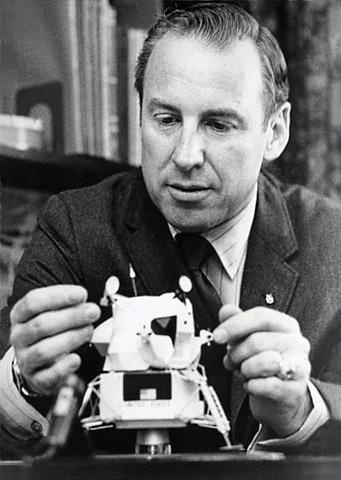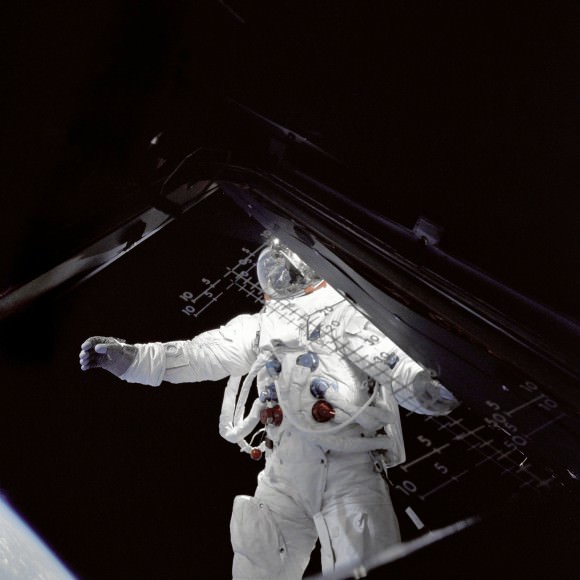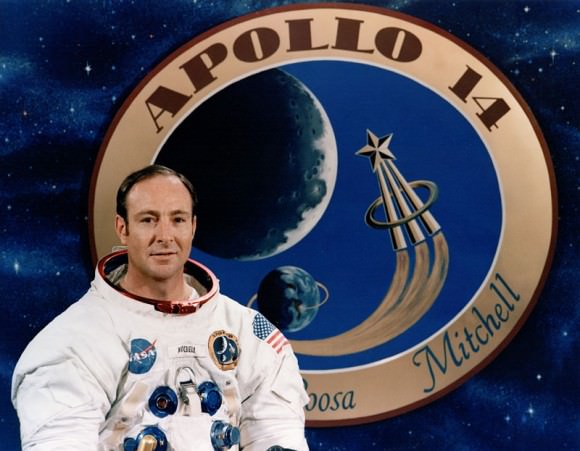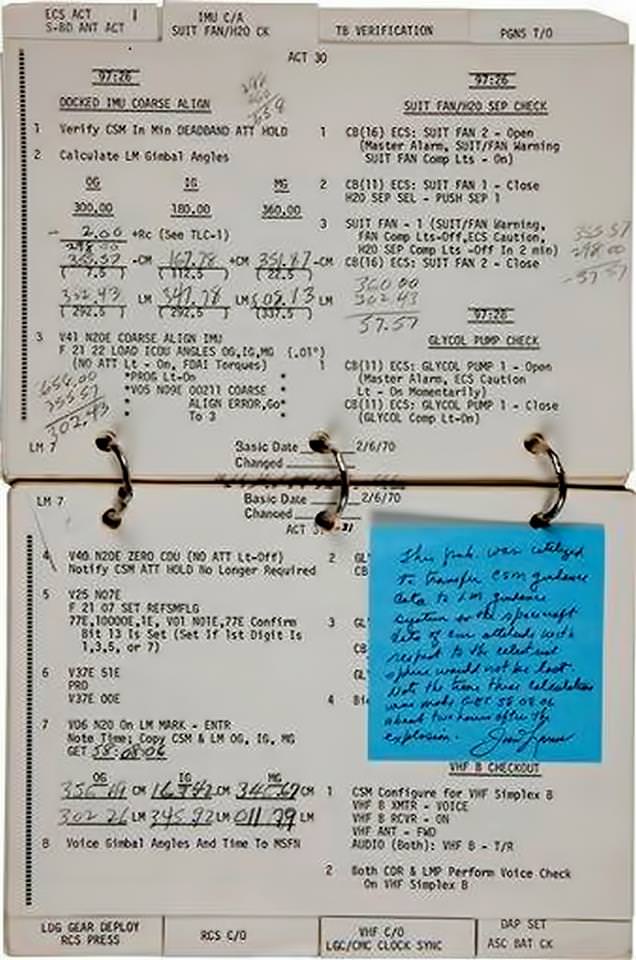[/caption]
Former NASA astronaut Jim Lovell came under fire last week when he sold a personal memento from his tenure with the space agency at an auction – the 70-page checklist from the famous Apollo 13 mission that didn’t land on the Moon. The sale has reopened the ongoing debate over who owns NASA artifacts and photographs, the astronauts or the public.

In Lovell’s case, the checklist is so valuable because it contains Lovell’s hand written calculations he used to navigate the crippled Apollo 13 spacecraft after its oxygen tank exploded. That’s a pretty important piece of history for many collectors. Bids on the historic item surpassed $388,000.
But now NASA is questioning whether Lovell had the right to sell the item and profit from its sale. For now, the checklist – along with a lunar module identification plate and a hand controller from Apollo 9 sold by former astronaut Rusty Schweickart and a glove Al Shepard wore on the Moon on Apollo 14 sold at the same auction – is locked in a Heritage Auctions vault until the issue is resolved.
NASA administrator Charles Bolden released a statement saying that there have been “fundamental misunderstandings and unclear policies” regarding items astronauts took home from the Mercury, Gemini, Apollo and Skylab mission.
These “misunderstandings and unclear policies” aren’t new. Last summer, NASA filed a lawsuit against Apollo 14 astronaut Ed Mitchell after he tried to sell a 16mm video camera he used on the Moon. NASA claimed Mitchell was selling the camera illegally and sued the former astronaut for ownership rights. Mitchell countered that the camera would have been left on the Moon had he not brought it home. It’s been sitting in his personal safe since 1971.
Mitchell isn’t wrong in his self defense. In the 1960s and 1970s, NASA officials told the astronauts that they could keep certain equipment from the missions.
In 2002, former Flight Director Chris Kraft said that he approved the policy. Apollo astronauts were allowed to keep personal items that flew with them as well anything from the lunar landing module that would otherwise have been abandoned on the Moon. The astronaut had great freedom in choosing what they wanted to keep.

“It was generally accepted that the astronauts could bring back pieces of equipment or hardware from this spacecraft for a keepsake of these journeys,” Kraft wrote.
Since the end of the space race, collectors around the world have paid millions to own pieces of history themselves. NASA’s problem isn’t with these former astronauts keeping pieces of history for themselves, it’s when they sell these artifacts for personal gain that creates a problem.
Kraft’s 2002 letter doesn’t address whether or not astronauts have the right to sell their mementos. In its recent letter to the auction house, NASA insisted only the agency can approve such artifacts for sale.
Bolden said the ownership discussions will explore “all policy, legislative and other legal means” to resolve ownership issues “and ensure that appropriate artifacts are preserved and available for display to the American people.” The agency has agreed to work cooperatively with the astronauts to resolve what’s recently become a contentious issue.

It is a bit of a grey area. The astronauts did the work, they trained for difficult mission and went to the Moon. But NASA footed the bill, and American tax payers funded NASA. The space agency argues that artifacts from the Apollo era should be available to the public. Everyone should be able to view and experience these pieces of one of the nation’s historic achievements.
Source: Yahoo! News


NASA is not the public. They should stop their asinine demands and lawsuits. These men risked their lives for us. Harassing them at this stage just gives the agency a black eye.
NASA is acting like a brat who let another kid keep his baseball years ago, and now wants it back because the kid wants to sell it. They should be putting 100% of their resources toward getting back to the Moon and then to Mars before everything up there is written in Chinese. But if they really just absolutely have to take back tax payer paid property, they should concentrate on all of those Moon rocks they can’t seem to find.
Ed Mitchell only wanted to sell his camera to pay for medical bills of his son that died of cancer.
NASA needs to shut up and disband. They gave manned flight to the Russians and Chinese and now they want to act like a banana republic dictator. jeez just leave the few heroes we have left alone. They didn’t pay them crap for risking everything so let them get something!
I suppose NASA will take the profits and deposit them in the US treasury then? hah
Let the Court of Public Opinion Decide, these hero’s were publicly funded, not having this stuff in a museum is not gonna hurt anyone. But if these men need to sell it for what ever is their reason so be it. One entity’s trash is another mans treasure. Get over it NASA, you have been robbing us for decades to the tune of billions of dollars in cost over runs buying from the highest bidder and shady practices. Now you want to stick your tentacles into Private Space, What you can do it for 50 million a launch something is wrong here SpaceX we know it costs billions and billions whats the deal.
With all due respect, this equipment is trash. Flotsam from a bygone era that only collectors and museums should be interested in.
NASA didn’t give a damn for these articles because initially the Apollo missions were a stepping stone to bigger things. The politicians didn’t care because they were a stunt to be forgotten as soon as the potential for embarrassment was averted.
To come back now and nitpick with old astronauts over who owns what is simply childish.
NASA should be focusing on making new milestones, not collecting the trappings of its lost decades.
Trash? Some of these items have been auctioned for hundreds of thousands of dollars. That’s some “trash”.
Many of the small tools and items NASA uses now are worth hundreds of thousands of dollars too.
They had no use for these old items other than for the historical value (which no one cared about until AFTER auctions started to rake in real money).
So yes, from NASA’s perspective, its trash.
We can debate the value of preserved trash, but its a simple fact that these are items that weren’t noticed as missing or deemed important at the time.
If you see a man selling the old couch you left at the bin, what grounds do you have to go and ask him for a cut of what he gets?
Also, something to ponder: If we stamp these things as government property and persecute the people who own them, its a good chance they’ll continue to remain underground and become lost or destroyed.
NASA isn’t offering any rewards on searching the basement for Apollo gear. Tossing a potential jail sentence and fines on top of that just means these things stay on the black market and will never be found.
Good points and thank you. Since the Administrator admits that historically there hasn’t been a clear or consistent policy, no one can be sure what’s out there, but there are ways to find out and restart with a clean slate.
This might be a solution:
(1) NASA’s Office of Inspector General (whose mission includes the prevention and detection of crime) holds an amnesty to document what’s out there and if necessary provides written authentication and consent(s) to such items remaining in private ownership.
(2) After the amnesty, there is zero-tolerance. Anything less than written approval from the Agency is treated as Employee Theft.
This way, nothing is left under the carpet, there are no hurt feelings, damaged reputations, lengthy litigations and everyone knows where they stand.
If NASA wanted Lovell’s checklist back, they should have grabbed it when the Command Module was being cleaned out after the mission ended, instead of kicking up a fuss more than forty years later. It is mean-spirited to deny these men some memento, to do with as they pleased, as part compensation for a job where the risks were barely outweighed by the benefits. The only job more dangerous than being an astronaut in the 1960s was being a kamikaze pilot in the 1940s.